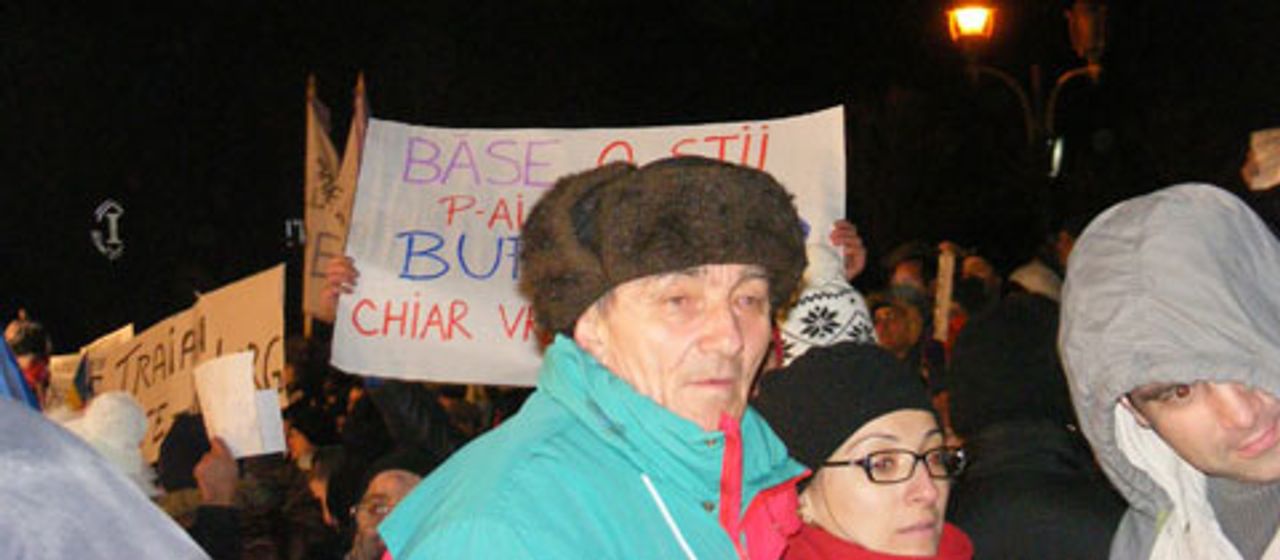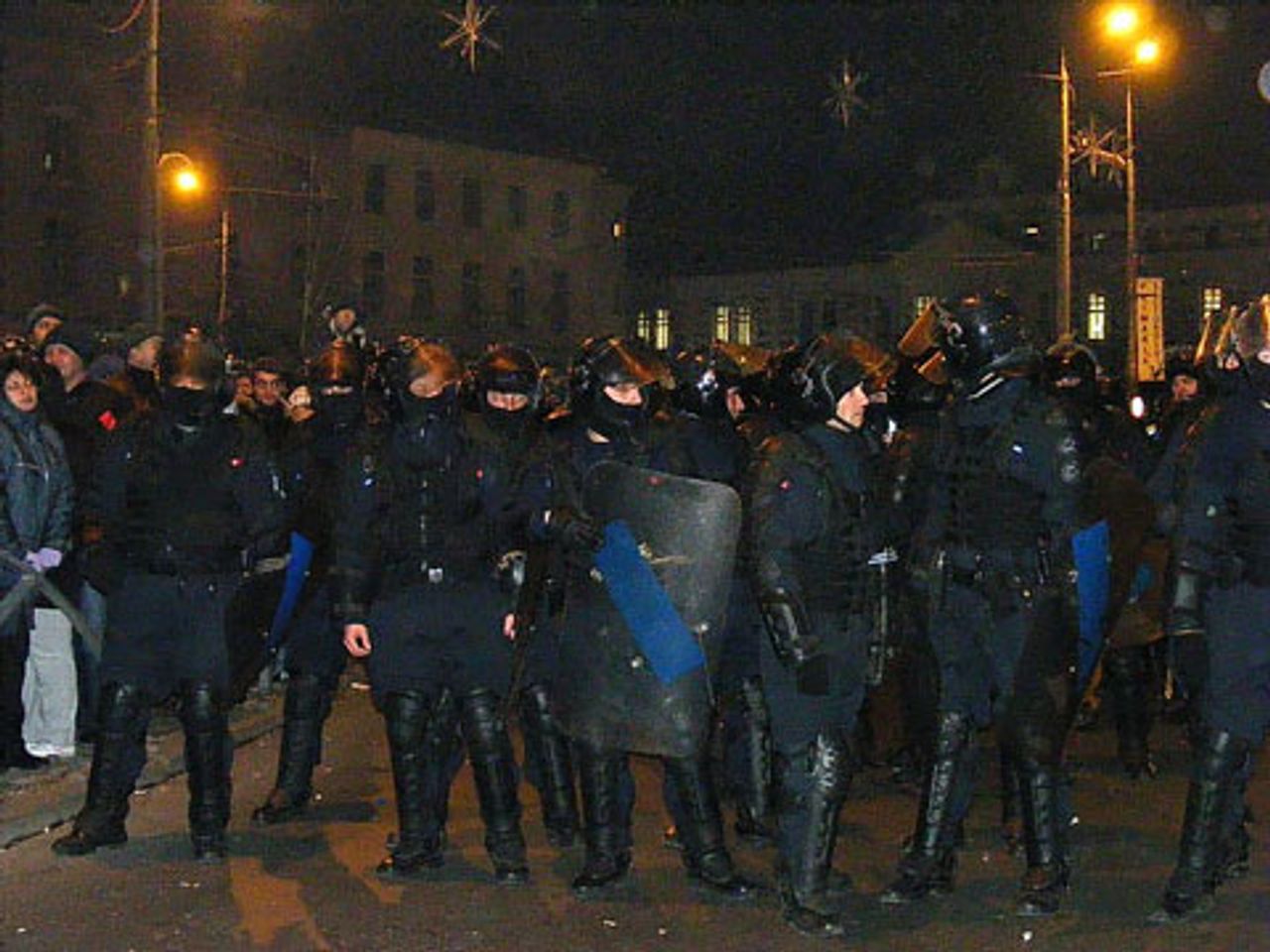As protests in Romania enter their second week, workers are facing increased pressure and threats from the ruling elite.
The first demonstrations were triggered by the forced resignation of Dr. Arafat, a member of government who had publicly opposed a health care bill that would privatise the Romanian public health system. President Traian Basescu, who personally championed the bill, quickly tried to ease tensions by withdrawing it on Friday, January 13, the first day that demonstrators gathered in Bucharest to protest outside the Presidential Palace.
 Demonstrators in Bucharest
Demonstrators in BucharestOn Saturday, more people tried to reach the Presidential Palace but were met with large numbers of riot police. Demonstrators then gathered in the center of Bucharest, in University Square, where police charged several times with tear gas and batons into a crowd with many children and large numbers of elderly.
Sunday saw the greatest use of force by the Romanian state since 1998, when paramilitary police were used to prevent striking miners from demonstrating in the capital, Bucharest. Even though the protest started peacefully, large numbers of riot police tried to forcefully break it up. Police forces then redeployed to prevent another group of protesters coming from nearby Unirii Square from joining with the main demonstration in University Square.
Some 400 students trying to make their way to the center of Bucharest were also stopped. Police committed numerous abuses throughout the night, beating and detaining protesters and bystanders alike.
 Riot police in Bucharest
Riot police in BucharestOn Monday, the Government again tried to resolve the situation by reinstating Dr. Arafat. This however did nothing to prevent the demonstrations, as people were by now demanding the resignation of the president and the government, which has repeatedly imposed tough austerity measures in recent years.
On Thursday, when a record number of people occupied University Square, police again dispersed protesters by force, sweeping the side streets, beating and hauling protesters into vans. Although the demonstrations were peaceful, police constantly sought to provoke the crowds. The press filmed and identified members of the Gendarmerie, the Romanian paramilitary police force, as well as thugs with known links to UNPR (National Union for the Progress of Romania), a member of the ruling coalition, at the demonstrations.
The main opposition parties, the Social Democrats and the pro-market National Liberals, who have formed the Social-Liberal Union, reacted to the protests with fear. They did not defend demonstrators against police violence and, through the voice of Liberal leader Crin Antonescu, claimed that riot police and protesters are “equal victims.” He made token calls for early elections. Antonescu called for “violent” protesters to be “identified and punished with maximum severity.”
The Social-Liberal Union held its own rally on Thursday, away from University Square. The main opposition parties, discredited by years of presiding over privatisations and the dismantling of social spending, are trying to scapegoat the government of Emil Boc (Democratic Liberal Party—PDL) for the current situation. They cannot offer any alternative to the IMF-imposed austerity measures and are not opposed to the cuts, accusing instead the government of a “lack of communication” in implementing them.
The opposition press has also run an aggressive campaign attacking demonstrators as “football hooligans,” claiming that the police did not act strong enough. They responded to the people’s denunciations of both political parties and to the booing of a prominent Liberal senator in the square by claiming that the protesters are agitators and supporters of President Traian Basescu.
The opposition press has also stepped up its yearlong campaign in support of the deposed former king of Romania, the 90-year-old Mihai I, and his conflict-ridden royal family.
The opposition is linked to the many petty-bourgeois groups active in University Square: various ecology groups, feminists, animal rights groups, and a host of anti-communist NGOs that try to make a comparison between current events and those in Bucharest in the early 1990s—when a power struggle erupted between a layer of former Stalinist bureaucrats and more right-wing parties and former dissidents.
The People’s Party, the nationalist and populist party of tabloid mogul Dan Diaconesu, was also present at the demonstrations, while members of the neo-fascist Noua Dreapta (New Right), an organisation with links to various far right forces, were driven out of the square on Saturday, January 21.
That such forces can posture as representatives of popular opposition is the result of the treachery and anti-working class actions of the Social Democrats and the trade unions. The unions have betrayed every struggle of the workers in past years—allowing the government to lay off 12,000 railway workers in 2009, and dissipating opposition among teachers to salary cuts and to new legislation allowing for competition and privatisation in the educational system. Against draconian social cuts agreed with the IMF, the unions called a single, toothless day of protest on May 19, 2010.
Three hundred teachers took part in the demonstrations in University Square on Friday, January 20, and again on Saturday, and calls were made for a general strike. Marius Nistor, a prominent union leader, declared, however, that he cannot put young teachers on strike because it would break their “work continuity”.
The demonstrations in Bucharest and other cities in Romania have been limited in numbers, a few thousand people at any one time, yet they were met with the full weight of the capitalist state. Often, riot police greatly outnumbered protesters, and there were press reports of teachers and students in dorms been threatened against participating in the protests. A prominent leader of the ruling Democratic Liberal Party, Radu Berceanu, threateningly declared that he could easily “gather 10,000 people” for a counter-demonstration, with only “a few phone calls”.
The recent protests in Romania are part of the re-emergence of international struggles of the working class. Romanian workers must overcome the great hurdles that Stalinism and its theory of “socialism in one country” have left behind and realise that the only way to fight the social cuts and attacks on living standards is through the international unity of the working class.
